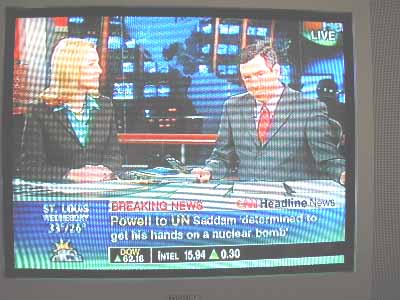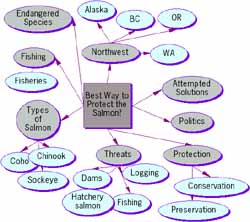|
|
| Vol 12|No6|February|2003 | |
|
Please feel free to e-mail this article to a friend, a principal, a parent, a colleague, a teacher librarian, a college professor, a poet, a magician, a vendor, an artist, a juggler, a student, a news reporter or anyone you think might enjoy it. Other transmissions and duplications not permitted. (See copyright statement below).
Sometimes the simple truth may not be the truth at all. Our students learn about their world through a streaming flow of sound bites and mind bytes that compress reality in ways that may distort while simplifying. Simple truth has been the stock in trade of charlatans and demagogues for decades, but the challenge of detecting such simple truths may have grown more difficult because of the changing modes of broadcast journalism. World News at a Glance Each day my cell phone sends me a world news update. Convenient, reliable and fast, the reports highlight three events. Imagine trying to select the three worth reporting and then compressing them into a few words. On February 3, 2003, the following news came to my cell phone:
Eighteen words to summarize world events! If you read those words carefully, it is difficult to make sense of them. Someone has compressed complex events and issues into mere fragments. Much like the headlines of newspaper stories, these few words suggest more than they explain. Unlike headlines, there is no story below them to fill in the missing content or explain what needs explaining. The Daily Horoscope Each day my cell phone sends me my horoscope. I don't take the message seriously. It gives me advice that I never heed. It comments, predicts and encourages in simple terms. On February 4, 2003, the following horoscope came to my cell phone:
If I thought horoscopes were helpful, I would wonder at the value of such a brief message. A Ticker Tape Reality Much TV news coverage has moved to split windows combining a streaming news tape on the bottom of the page while the basic news reporting occurs in a large window.
The viewer can multi-task, following the stock market, the weather, breaking news and whatever interview is taking place in the main screen. For those with attention deficits, the new format supports a kind of information wanderlust. But just how truthful is the ticker tape? In squeezing complex stories and realities into choppy little sentences, how much do we lose in the way of content, explanation, context and clarity? On the morning when the above picture was captured, the running ticker tape coverage was excellent at summarizing the main points of a presentation by the American Secretary of State to the United Nations. The February 5th speech was so important that CNN offered up several dozen sentences, each one of which was a major point made by the Secretary. The content was superb - much like a thorough newspaper report. On other days, when there is no single story worthy of depth and focus, most stories win a single sentence similar to the cell phone examples provided earlier. Since the program is actually called "Headline News," its producers could fairly claim that viewers have been forewarned to expect snippets and headings. Reading these brief messages, one wonders if they are snippets1, tidbits2 or treats3.
Life for Dummies? While the instructional series Software for Dummies may have sold well and been popular, reduction of life into byte size morsels is not a healthy trend. We live in an age of platitudes and aphorisms. Truth must, it seems, be cleverly packaged, brief and not very demanding. It must be palatable and attractive. When leaders reduce complicated issues into simple phrases and slogans, they do a disservice to the notion of democratic debate and policy-making. Implications for Schools Previous issues of FNO have warned against the onset of MentalSoftness™ (see May 2000 issue of FNO - "Beyond Information Power.") Unless we take care to develop the foundations for rigorous independent thought, we risk raising a generation of young people inclined to accept the sound bites, mind bytes, eye candy and mind candy so typical of the new information landscape. There are, after all, millions being spent on marketing to shape the thinking of consumers and citizens. Misinformation and infotainment are rampant, with simple answers to complex questions appearing like the dandelions of spring - bright, appealing, widespread and persistent.
What are the antidotes to protect this generation of students from simplistic thinking? For more than a decade now, FNO has argued for a shift in school research away from topical research to a focus upon problem-solving and decision-making that would require students to wrestle with complexity. Such research must occur throughout the school year on a continuing basis so that students develop the "habits of mind" to sustain meaningful inquiry and idea building.
Strategies to Make Research Constant The February 1999 issue of FNO described in some detail how to employ each of the following three strategies to make research a daily event:
We must consider how these strategies might counter decades of school practice - the oversimplification and compression of history, science and literature into a series of bite-sized curriculum snippets delivered as period-sized morsels on a daily basis, thanks to the reductionism of school textbooks. It is no small irony that the reductionism of TV news reinforces the reductionism of textbook learning. Ownership of these media has consolidated in recent years until entertainment, news, testing and educational publishing combine under global firms with little commitment to the journalistic or educational ethics of earlier times. Profits and ratings drive the creation and serving of content. Sensationalism, provocation and hyperbole rule across the media. Complicating the challenge facing schools and teachers are state tests and standards that often place too much emphasis upon factual content at the same time they stress the need for analysis, interpretation, inference and synthesis. The focus on content puts enormous pressure on teachers to slip into a reductionist mode - as if learning U.S. history, biology or any other subject were a matter of consuming 180 snacks. This fast food approach to learning undermines the very "habits of mind" mentioned earlier, most of which require a certain amount of patience, persistence, depth and pondering. Compounding the challenge presented by high-stakes testing and content-bloated state (or provincial) standards is the ferocious impact of NCLB/ESEA, especially upon schools serving disadvantaged populations. The purposes of schooling are reduced to a thin gruel that could hardly sustain either heart or mind, let alone a vibrant democratic society. It seems late in human history to be returning to a Dickensian social ethos, but American children face a decade of risky educational experimentation fueled by radical notions hiding under seemingly pleasant titles. The reality of NCLB is more likely to win the label "Helter-Skelter" than the pseudo-reform label promoted by its advocates. Since FNO has been primarily devoted to issues and possibilities raised by the introduction of new technologies to schools, FNO Press has created a new educational journal devoted to the repeal or radical amendment of NCLB - http://nochildleft.com. Free subscriptions are available at http://nochildleft.com/subscribe.html. |
|
Back to February Cover
Credits: The photographs were shot by Jamie McKenzie Copyright Policy: Materials published in From Now On may be duplicated in hard copy format if unchanged in format and content for educational, nonprofit school district and university use only and may also be sent from person to person by e-mail. This copyright statement must be included. All other uses, transmissions and duplications are prohibited unless permission is granted expressly. Showing these pages remotely through frames is not permitted. FNO is applying for formal copyright registration for articles. Unauthorized abridgements are illegal.
|
 From Now On
From Now On

